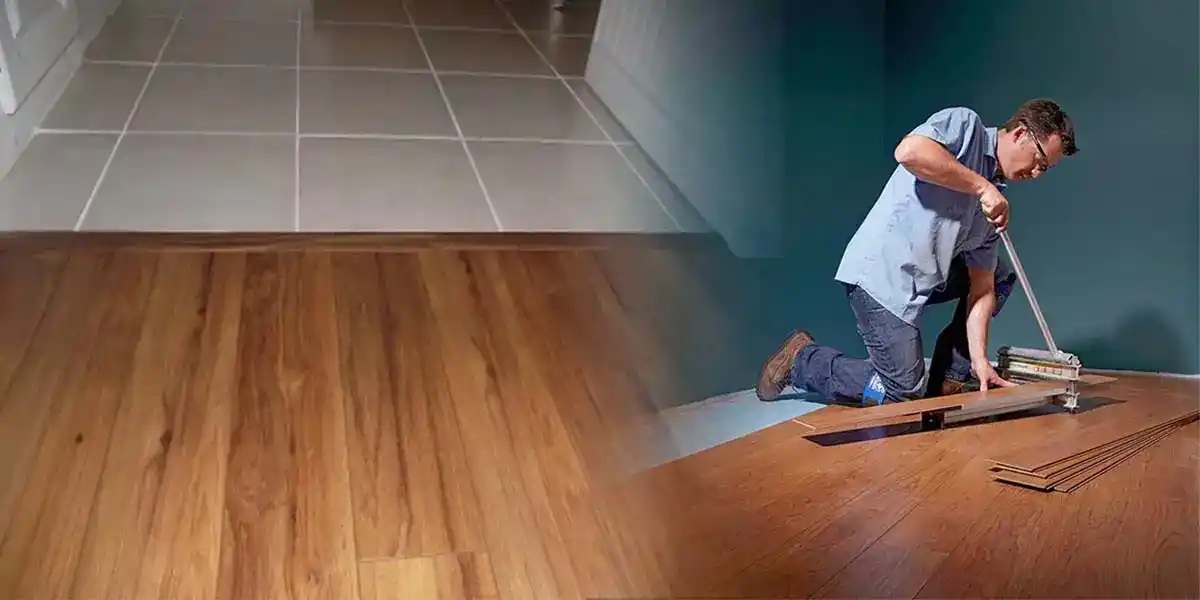Are you considering renovating or updating your flooring? Well, laminate flooring can be a great option. But, what if you already have ceramic tiles in place?
Nothing to worry about, you are not the only one who is worried “Can you put laminate flooring over ceramic tile?”
Yes, it is possible to install laminate flooring over any type of ceramic tile. But it’s important to proper preparation.
Ensure the ceramic tile is clean, level, and in good condition. Fill in any fine lines and uneven spots. Also, you must check tile condition, stability, and height clearance.
In this article, you can find a detailed guide on how to install laminate flooring over ceramic tiles. So let’s start. But first, you need to know what things to consider before installing laminate over tile.
You Might Also Like:
- Can You Nail Down Laminate Flooring? (Answered)
- Can I Use Laminate Flooring On Walls? (Installation Guide Included)
Things to Consider Before Installing Laminate Flooring Over Ceramic Tile
- Surface Irregularities and Cracks: Ensure that the ceramic tile surface is even, smooth, and free from cracks or damage. Any imperfections can affect the installation and appearance of laminate flooring.
- Height and Clearance: Remember that installing laminate over ceramic tile will increase the floor height. So, consider door clearances, transitions, and adjacent flooring. It ensures no obstructions or compatibility issues.
- Moisture and Water Resistance: Ceramic tiles offer better moisture resistance than laminate flooring. Assess moisture levels, especially in bathrooms, kitchens, or other high-moisture spaces. Then, install a moisture barrier and water-resistant laminate flooring.
- Stability and Adhesion: The stability and adhesion of ceramic tiles are crucial. Loose or unstable tiles can cause movement and affect laminate flooring integrity. Ensure that the tiles are securely adhered to the substrate.
- Subfloor Compatibility: Ensure the subfloor beneath the ceramic tile is suitable for installation. Concrete, plywood, or other appropriate subfloor materials should be clean, dry, and level.
- Transition Strips and Molding: Create a smooth transition between laminate flooring and tile. By using transition strips or molding.
- Manufacturer Recommendations: Refer to the manufacturer’s guidelines and installation instructions for laminate flooring. Ensure that installing it over ceramic tile is supported and within warranty guidelines.
Also See: How to Choose Laminate Flooring: A Buyer’s Guide
How to Install Laminate Flooring Over Ceramic Tiles?
Step 1: Supplies Needed
The first step you need to do before starting the installation process is to gather all the necessary tools.
- Cutting tools (Circular Saw, Jigsaw, or Laminate Cutter)
- Cleaning supplies
- Adhesive
- Measuring tape
- Straight Edge or Carpenter’s Square
- Spacers
- Tapping Block
- Safety goggles
- Work Gloves
Step 2: Preparing Ceramic Tile for Laminate Flooring
Using a sweeping or vacuuming action, thoroughly remove all dust, dirt, and debris from the ceramic tiles. Ensure the surface is clean, dry, and free of any contaminants affecting the installation process.
Step 3: Fix any Damaged Tiles or Loose Tiles
Once the tiles are clean and dry, repair them for cracks or chips. Replace cracked or broken tiles and re-adhere loose tiles using appropriate adhesive.
Before proceeding, the surface should be stable and in good condition.
Allow the adhesive to dry completely before continuing with the next step. If necessary, sand the surface to ensure a smooth finish. Then you can move on to the next step of the process.
Step 4: Leveling and Filling in Grout Lines
Ensure that the grout lines between the ceramic tiles are in good condition.
Fill in any uneven or recessed areas of the grout with a suitable leveling compound or grout filler if they are uneven or recessed.
Let the surface dry completely before proceeding and smooth out any rough areas.
Step 5: Identify Moisture Sources
Determine if there are any potential moisture sources in the area, such as leaks in the plumbing or excessive humidity in the air. Before starting the installation process, it is important to address these issues.
Use a moisture barrier if the manufacturer recommends it or if it is necessary for the location in question.
Step 6: Underlayment Preparation
Roll out the underlayment over the whole ceramic tile surface. It should be cut to fit, leaving a small gap around protruding objects and the edges. Use adhesive or tape to secure the underlayment according to the manufacturer’s instructions if necessary.
Step 6: Installing Laminate Flooring
Start by installing the first row of laminate flooring planks along the starting wall, allowing for expansion space.
Make sure that the gap between the planks and the walls is maintained with spacers. As you install the next rows, connect the planks using a click-lock or adhesive method.
Must See: Laying Laminate Flooring: 13 Common Mistakes to Avoid!
Step 7: Installing Baseboards & Finishing Touches
Lastly, cover the expansion gap around the room’s perimeter with baseboards or quarter-round moldings.
Where laminate flooring meets other types of flooring or between rooms, install transition strips. To achieve a polished finish, perform any necessary touch-ups or cleaning.
Pros and Cons of Installing Laminate Flooring over Ceramic Tile
Pros
- Cost-effective: Overlaying laminate flooring over ceramic tile can be a cheaper alternative to removing tiles and installing new flooring.
- Time-saving: Taking ceramic tiles out can be laborious and time-consuming. Directly installing laminate flooring over tiles saves time and effort.
- Aesthetics: With laminate flooring, you can update the look of your space without having to replace the existing tile.
- Ease of installation: When installed over a flat and stable surface like ceramic tile, laminate flooring is generally easy to install. Making it a good DIY choice.
Cons
- Height and transition issues: Installing laminate flooring over ceramic tile will increase the overall floor height, potentially creating door clearance problems. You may need to adjust or add transition strips.
- Moisture concerns: Installing laminate over tile in areas prone to moisture, such as bathrooms or kitchens, may require extra precautions to prevent water damage.
- Stability and durability: Laminate flooring installation requires ceramic tile stability and adhesion. Having loose tiles or poor condition can affect laminate flooring’s durability and longevity.
- Subfloor compatibility: Install laminate flooring over a suitable subfloor. If the subfloor is uneven or damaged, address it before proceeding.
- Limited repair options: Damage to laminate flooring or ceramic tile underneath can be challenging to repair or replace. Depending on the situation, the laminate may have to be removed.
Tips and Best Practices After Installing Laminate Flooring Over Tile
For laminate flooring to stay in good condition, there are some tips and best practices to follow after installation over tile.
- Allow Time to Settle: Allow the newly installed laminate flooring time to settle and stabilize before moving furniture. Follow the manufacturer’s instructions for the specific period.
- Regular Cleaning: Regularly clean laminate flooring to maintain its appearance. To remove stains or spills, use a damp mop and a mild laminate floor cleaner to sweep or vacuum the floor. Avoid excessive watering, as laminate flooring is not waterproof.
- Avoid Abrasive Cleaning Tools: Use a soft cleaning tool such as a microfiber mop or a soft bristle broom. Do not use abrasive cleaning pads or scrub brushes on laminate surfaces.
- Protect from Moisture: Despite laminate flooring’s moisture resistance, it still needs to be protected from excessive moisture. Clean up spills immediately, and use mats or rugs in areas prone to water, such as near sinks or entryways.
- Use Protective Pads: Protect laminate flooring from scratches by placing felt or rubber pads under furniture legs. Avoid dragging heavy furniture across the floor by using furniture sliders or lifting it.
- Avoid Excessive Sunlight Exposure: Laminate flooring can fade or discolor when exposed to direct sunlight. Use curtains, blinds, or UV-blocking window films to minimize sun exposure, or consider area rugs to protect flooring in areas with intense sunlight.
- Address Minor Damage Promptly: Address minor damage, such as scratches or chips, as soon as possible. Use a laminate floor repair kit or color-matched putty to fill in the damaged area.
- Follow the Manufacturer’s Guidelines: Make sure you follow the manufacturer’s instructions for laminate flooring care and maintenance. Depending on the laminate product, cleaning products, techniques, and warranty policies may differ.
FAQs: Can You Put Laminate Flooring Over Ceramic Tile?
Can I install laminate flooring over ceramic tile in a bathroom or kitchen?
Yes, you can install laminate flooring over ceramic tile in a bathroom or kitchen. Make sure the ceramic tile is clean, level, and in good condition.
It is recommended you should use moisture-resistant laminate and follow the manufacturer’s instructions. Make any necessary adjustments to ensure a smooth transition considering the height difference.
Can laminate flooring be installed over damaged ceramic tiles?
Installing laminate flooring over damaged ceramic tiles is not recommended.
To ensure an even and stable surface, it is important to replace or repair damaged tiles. It’s possible to compromise laminate installation integrity if tiles are over-damaged.
Do I need underlayment for laminate flooring over the tile?
Yes, you will need underlayment before laying laminate flooring over the tile. It provides cushioning, dampens noise, and smooths out any minor imperfections on the tile surface.
Also, it acts as an extra insulation layer and moisture barrier.
Can you put peel-and-stick laminate over the tile?
Yes, you can install peel-and-stick laminate flooring over tiles. But it’s essential to ensure durability.
To achieve this, make sure the tile surface is clean, flat, and free of debris or moisture. Proper preparation and following manufacturer instructions are crucial for a successful installation.
Read More on Laminate Floors
- Laying Laminate Flooring: 13 Common Mistakes to Avoid!
- The Best Way to Level a Concrete Floor For Laminate Flooring (Must Read!)
- Can I Use Laminate Flooring On Walls? (Installation Guide Included)
- Can You Nail Down Laminate Flooring? (Answered)
- 7 Best Furniture Pads for Laminate Floors (Buying Guide Included)





